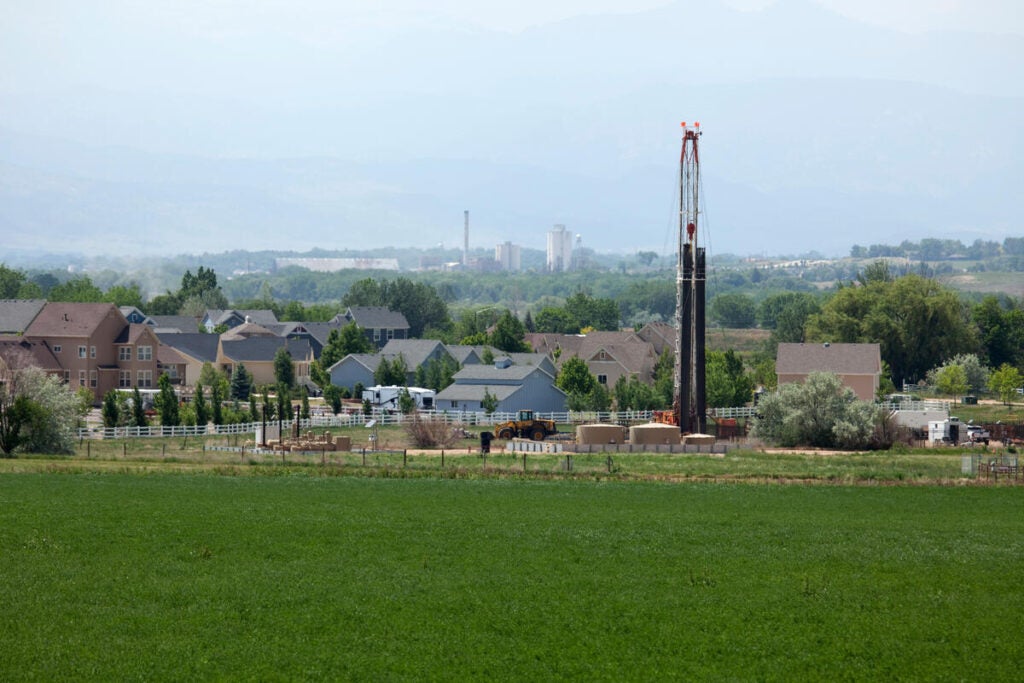
It’s common to find oil and gas drill rigs in or very close to residential areas in Colorado’s Front Range, like this one in the town of Frederick, which neighbors Broomfield (Getty Images photo).
A new study from Environmental Defense Fund finds that even oil and gas production that uses the most stringent emissions reductions technologies poses health risks to nearby residents. We collaborated with researchers from Colorado State University, Ajax Analytics, and the Colorado School of Public Health to study the cumulative risks posed by volatile organic compounds (VOCs) and ozone to communities living along Colorado’s Front Range.
The study, published in Environmental Health Perspectives, found that for communities located 1,000 feet from unconventional oil and gas (UOG) sites (i.e. sites that utilize fracking technologies), acute health risks to multiple organ systems persist during the periods of pre-production and production, even when emissions reductions strategies are implemented to cut pollution.
Robust data sets from Colorado
In 2018, the City and County of Broomfield implemented an extensive air quality monitoring system and inspection program in response to community concerns about exposure from new oil and gas development. Colorado’s Front Range, which includes Broomfield, has been in violation of the National Ambient Air Quality Standards (NAAQS) for ozone for several years.
It is well established that ozone can harm respiratory health, but less attention has been given to understanding the combined risks from inhaling oil and gas-related VOC pollutants in an area with high ozone levels. We combined air quality measurements collected near oil and gas and community sites in Broomfield with EPA ozone data collected within the Denver-Metro North Front Range Ozone Non-Attainment area. By evaluating these pollutants together, we gain a more accurate picture of real-world exposure—one that captures the health risks from breathing in a mixture of air pollutants.
For the study, which was published in Environmental Health Perspectives this month, we analyzed this data by developing a novel cumulative risk framework to understand how both short- and long-term exposure to multiple chemicals from oil and gas operations, along with exposure to background ozone, can impact human health.
Cumulative risk matters
Our Cumulative Human Health Risk Assessment goes beyond standard risk assessment frameworks by analyzing how inhaling multiple chemicals can affect multiple organ systems within the body. These kinds of risk assessments strengthen our understanding of real-world impacts, because humans are not exposed to one pollutant at a time, and that exposure does not impact only one system at a time.
We also examined which oil and gas activities were occurring when large plumes of VOCs were released into a nearby community 1,000 feet away from aUOG site. We found that separator maintenance, which occurs periodically throughout the production phase, was associated with large concentrations of VOCs. Our analysis showed that this activity can pose risks to pregnant women and children, the respiratory system and the human body’s ability to fight infections. When background levels of ozone were high, the addition of VOCs from oil and gas pushed risk above EPA thresholds.
Decades of health risks
Our study demonstrates that people who live 1,000 feet from UOG sites face risks, even when companies implement best management practices to reduce emissions. In Colorado’s Front Range, communities already face significant ozone pollution, especially in the summer when high temperatures make the pollution even worse.
Given that UOG production can last more than 30 years at a single site, health risks should be assessed from not only oil and gas related-VOCs during production, but also in combination with background ozone levels. Policymakers should take that into account when permitting new drilling sites that are near homes, schools or areas that could be developed in the future within the state setback zone of 2,000 feet.
These kinds of exposures could be blunted. Oil and gas operators could reduce exposure to some of the worst pollution by limiting activities like drilling during the summer when ozone is especially high. On high ozone days, people are often asked to modify their activities to reduce pollution. Oil and gas companies could do the same.









